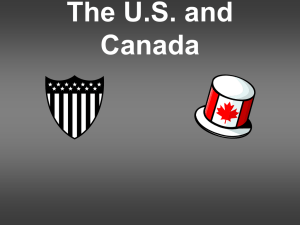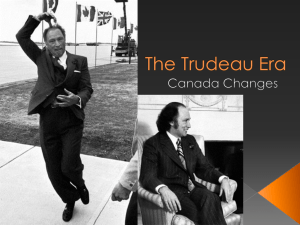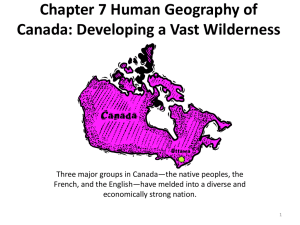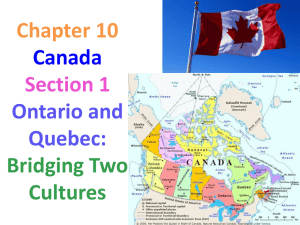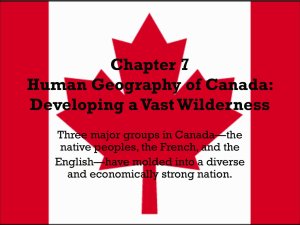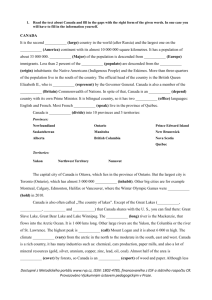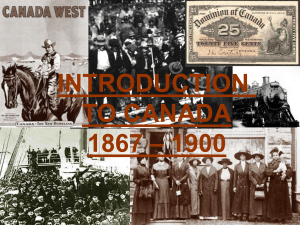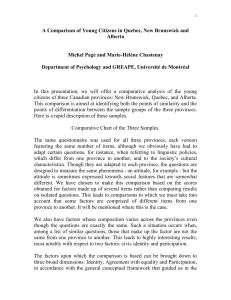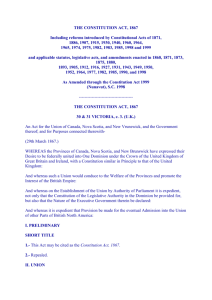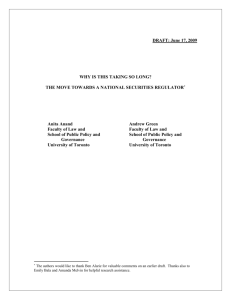Demographics in Canada Power Point
advertisement
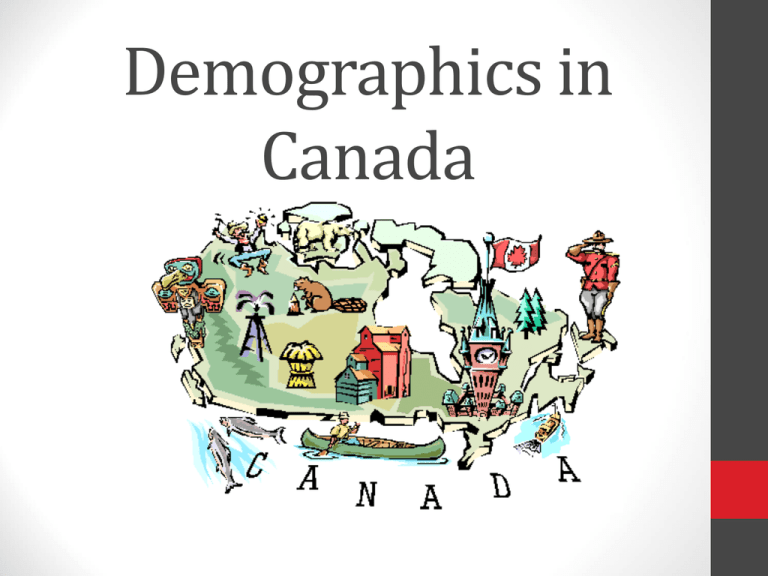
Demographics in Canada • Demographics – The study of population statistics • Birth Rate – number of births per 1000 people in a population • Death Rate – number of death rates per 1000 people in a population • In Canada our birth rate is 11.1 births per 1,000 people in a population and our death rate is 7.74 deaths per 1,000 people in a population. • If the birth rate is higher than the death rate, a population increases naturally. If the death rate is higher than the birth rate, a population will decrease naturally. • Fertility Rates – number of live births for every woman age 1545. • The fertility rate in Canada is much lower than many African countries. Why would this be? • Infant Mortality Rate – number of deaths for every 1000 births. • The infant mortality rate is much higher in many African countries than Canada. Why would this be? • Migration – when people leave one place for another • Immigration – moving to a foreign country as a place of permanent residence • Emigration – leaving one country for another • Net migration – comparing the number of people immigrating to a country to the number of people emigrating to another country. • Population density – the number of people in a measured area. • Population distribution – the pattern of population in an area. • Review: What is the difference between Immigration and Emigration? • Do you think that in Canada we have a higher rate of Immigration or Emigration? • What happens when a country experiences a very high Emigration rate? What are some factors that might contribute to a high rate of Emigration? • What happens when a country experiences a high Immigration rate? What are some factors that might contribute to many people Immigrating to a country? • Population Distribution in Canada • After looking at the pie graph on the previous slide, why do you think that Canada’s population is distributed the way that it is? • Alberta, British Columbia, Quebec and Ontario make up the majority of Canada’s population. Why do you think these provinces have such a large population? What factors would contribute to people moving there from other provinces? • The Yukon, Northwest Territories, Nunavut and Prince Edward Island each make up less than 1% of Canada’s population. Why do you think this is so? • Can you think of any reasons why people born in these provinces or territories might move away to another province? • Factors influencing Population Patterns and Distribution • Economic factors play a huge role in people deciding where to live or where to move. Factors such as: • Enterprise and Economy • Industry increasing/decreasing • Family reasons Largest Cities in Canada Rank City name Province Pop. Rank City name Province 1 Toronto Ontario 2,615,060 2 Montreal Quebec 3 Calgary 4 Pop. 11 Quebec City Quebec 516,622 1,649,519 12 Surrey British Columbia 468,251 Alberta 1,096,833 13 Laval Quebec 401,553 Ottawa Ontario 883,391 14 Halifax Nova Scotia 390,096 5 Edmonton Alberta 812,201 15 London Ontario 366,151 6 Mississauga Ontario 713,443 16 Markham Ontario 301,709 7 Winnipeg Manitoba 663,617 17 Vaughan Ontario 288,301 8 Vancouver British Columbia 603,502 18 Gatineau Quebec 265,349 9 Brampton Ontario 523,911 19 Longueuil Quebec 231,409 10 Hamilton Ontario 519,949 20 Saskatoon Saskatchewan 222, 189 • Review: Name as many of the ten largest cities in Canada as you can, as shown on the last slide. • What are some possible reasons that these cities are so large? • As more people move to these places, what happens to the cities? Is it usually a good thing or a bad thing to have many people moving to a particular city? • Another factor that contributes to the study of demographics in Canada is age. • Median age: A number that summarizes the age distribution of a population. • Statistics Canada performs regular studies to find out the median age of people living in different provinces. • Take a guess: What do you think the median age in Canada is? • What do you think the median age in New Brunswick is? Do you think it is higher or lower than the median age in Canada. Median Age in Canada: 40.6 years • male: 39.6 years • female: 41.5 years Median age by province and territory, 2011 Census • • • • • • • • • • • • • Nova Scotia: 43.7 Newfoundland and Labrador: 44.0 New Brunswick:43.7 Quebec: 41.9 British Columbia: 41.9 Prince Edward Island: 42.8 Ontario: 40.4 Saskatchewan: 38.2 Yukon: 39.1 Manitoba: 38.4 Alberta: 36.5 Northwest Territories: 32.3 Nunavut: 24.1 • After looking at the median age of Canadians living in different provinces, what did you notice? Did anything surprise you? • You may have noticed that the median age of females is higher than the median age of males. Why do you think this is? • You may have also noticed that the median age of people living in Nunavut is significantly lower than any other province or territory in Canada. Why do you think this is so? Population Growth Rates in the last 5 years Rank Province or Territory % Change 1 Ontario 5.7 2 Quebec 4.7 3 Alberta 10.8 4 British Columbia 7.0 5 Saskatchewan 6.7 6 Manitoba 5.2 7 New Brunswick 2.9 8 Newfoundland and Labrador 1.8 9 Nova Scotia 0.9 10 Prince Edward Island 3.2 11 Yukon 11.6 12 Nunavut 8.3 13 Northwest Territories 0.0 Total Canada 5.9 • You may have noticed that some provinces have had significant increases in population over the last 5 years. • Nunavut, The Yukon, and Alberta were the three provinces or territories that increased the most. Why do you think each of these provinces or territories would experience such a significant increase? • Newfoundland and Labrador, Northwest Territories and Nova Scotia experienced the lowest amount of growth over the last 5 years. Why do you think this is? What did you learn? • Name at least one interesting thing you learned from this presentation. • Did anything you heard today surprise you? • Was there any facts you saw today that you already knew?
